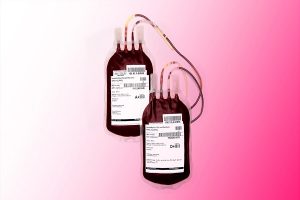
Artificial blood, also known as blood substitutes, has been a topic of intense research and development in the medical field for many years. The goal of artificial blood is to provide a safe, readily available alternative to human blood for transfusions, with the potential to save countless lives in emergency and surgical situations.
One of the biggest challenges facing the use of human blood for transfusions is the shortage of blood donations, as well as the risk of disease transmission and the need for compatibility testing. Artificial blood offers a potential solution to these challenges, as it can be manufactured on a large scale and does not carry the risk of disease transmission.
There are several types of artificial blood being developed, each with its own unique properties and advantages. Some of the most promising types of artificial blood include hemoglobin-based oxygen carriers (HBOCs), perfluorocarbon-based oxygen carriers (PFCs), and polymer-based oxygen carriers (PBOCs).
HBOCs are designed to mimic the function of hemoglobin in human blood, carrying oxygen from the lungs to the tissues and carrying carbon dioxide from the tissues to the lungs. PFCs are transparent liquids that can dissolve high levels of oxygen and are used in a variety of medical applications, including artificial blood. PBOCs are synthetic polymers that can carry and release oxygen, making them useful in medical applications such as artificial blood.
Top 5 Challenges in Artificial Blood:
The development and implementation of artificial blood as a viable alternative to human blood for transfusions is facing several challenges. The following are some of the top 5 challenges in the field of artificial blood:
- Safety concerns: One of the biggest challenges in the development of artificial blood is ensuring its safety for use in medical applications. There have been concerns raised about the potential side effects and long-term health risks associated with artificial blood.
- Efficacy: Another challenge is to ensure that artificial blood is as effective as human blood in transporting oxygen and other important substances throughout the body. The ability of artificial blood to mimic the functions of human blood is crucial to its success as a viable alternative.
- Regulatory approval: The development of artificial blood is subject to strict regulatory requirements, and obtaining approval from regulatory bodies such as the US Food and Drug Administration (FDA) is a major challenge. This process can be time-consuming and expensive, and there is no guarantee of approval.
- Cost-effectiveness: The cost of producing artificial blood on a large scale is a significant challenge, and it must be economically viable if it is to be widely adopted as a viable alternative to human blood.
- Compatibility: One of the key challenges in the development of artificial blood is ensuring that it is compatible with the human body and does not cause adverse reactions. Compatibility testing is crucial in ensuring the safety and efficacy of artificial blood for use in medical applications.
Advantages of Artificial Blood:
- Unlimited supply: One of the biggest advantages of artificial blood is that it can be manufactured on a large scale, providing an unlimited supply for medical use. This can help to address the shortage of human blood donations and ensure that patients receive the transfusions they need, regardless of the availability of human blood.
- Reduced risk of disease transmission: Artificial blood does not carry the risk of disease transmission associated with human blood transfusions. This is because it is not derived from human donors and does not require compatibility testing before use.
- Improved patient outcomes: By providing a safe and effective alternative to human blood for transfusions, artificial blood has the potential to improve patient outcomes and save lives in emergency and surgical situations.
- Ease of storage: Artificial blood has a longer shelf life than human blood and does not require refrigeration, making it easier and more cost-effective to store and transport.
- Increased versatility: Artificial blood can be designed and manufactured to meet specific needs and requirements, offering increased versatility and flexibility in medical applications.
In conclusion, artificial blood has the potential to be a breakthrough in modern medicine, offering a safe, readily available alternative to human blood for transfusions. Despite the challenges that must be overcome, the future of artificial blood is promising and holds the potential to save countless lives and improve patient outcomes.
Contact Us:
David Correa
USA/Canada (Toll Free): +1-800-792-5285, +1-503-894-6022
help@alliedmarketresearch.com

